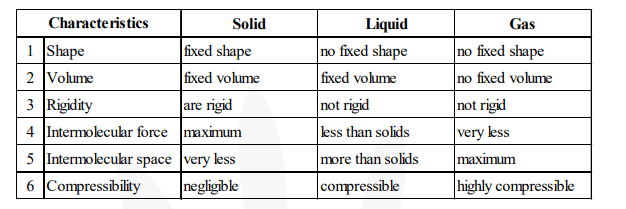Question.
(a) Tabulate the differences in the characteristics of states of matter.
(b) Comment upon the following: rigidity, compressibility, fluidity, fliling a gas container, shape, kinetic energy and density.
(a) Tabulate the differences in the characteristics of states of matter.
(b) Comment upon the following: rigidity, compressibility, fluidity, fliling a gas container, shape, kinetic energy and density.
Solution
(a) Difference in the characteristics of 3 states of matter

(b) Comment on:
(i) Rigidity. The tendency of a substance to retain/maintain their shape when subjected to outside force.
(ii) Compressibility: The matter has intermolecular space. The external force applied on the matter can bring these particles closer. This property is called compressibility. Gases and liquids are compressible.
(iii) Fluidity: The tendency of particles to flow is called fluidity. Liquids and gases flow.
(iv) Filling of a gas container. Gases have particles which vibrate randomly in all the directions. The gas can fill the container.
(v) Shape: Solids have maximum intermolecular force and definite shape. Whereas liquids and gases takes the shape of container.
(vi) Kinetic energy. The energy possessed by particles due to their motion is called kinetic energy. Molecules of gases vibrate randomly as they have maximum kinetic energy
(vii) Density. It is defined as mass per unit volume, the solids have highest density.
(a) Difference in the characteristics of 3 states of matter

(b) Comment on:
(i) Rigidity. The tendency of a substance to retain/maintain their shape when subjected to outside force.
(ii) Compressibility: The matter has intermolecular space. The external force applied on the matter can bring these particles closer. This property is called compressibility. Gases and liquids are compressible.
(iii) Fluidity: The tendency of particles to flow is called fluidity. Liquids and gases flow.
(iv) Filling of a gas container. Gases have particles which vibrate randomly in all the directions. The gas can fill the container.
(v) Shape: Solids have maximum intermolecular force and definite shape. Whereas liquids and gases takes the shape of container.
(vi) Kinetic energy. The energy possessed by particles due to their motion is called kinetic energy. Molecules of gases vibrate randomly as they have maximum kinetic energy
(vii) Density. It is defined as mass per unit volume, the solids have highest density.
Comments
Click here to get exam-ready with eSaral
For making your preparation journey smoother of JEE, NEET and Class 8 to 10, grab our app now.
